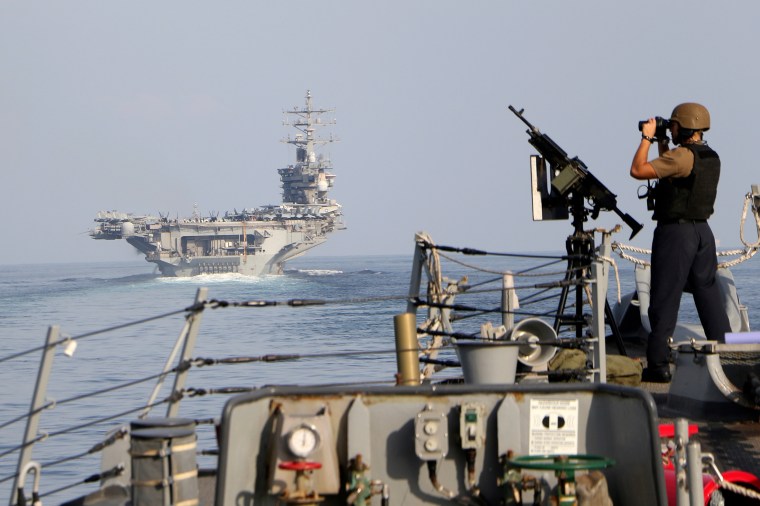WASHINGTON — Amid growing calls for President Joe Biden to order a stronger military response to repeated attacks by Houthi rebels on shipping in the Red Sea, members of his national security team convened a White House meeting Wednesday to review possible options, including strikes against Houthi targets in Yemen, according to two current administration officials.
The meeting Wednesday afternoon was aimed at fleshing out details of various options that are more robust than those the White House has previously considered, which could include responding alongside other countries, the officials said. It was a principal deputies committee meeting, chaired by deputy national security adviser Jon Finer, with the goal of ultimately presenting the president with a list of military options.
So far, the White House has not approved any of the options for strikes on the Yemen-based rebels that have been prepared by the U.S. military, current and former officials said.
After the Houthis launched their most direct attack on the U.S. military on New Year's Eve, firing on U.S. Navy helicopters from small boats, the helicopters returned fire, sinking three boats and killing 10 fighters, the U.S. military said.
According to the officials, U.S. Central Command provided Defense Department leaders with options for an additional military response after the incident, and the Pentagon sent those options to senior White House officials. Biden, who was on vacation in St. Croix in the U.S. Virgin Islands, did not approve an additional military response.
Biden was updated multiple times on the situation in the Red Sea while on vacation.
An administration official denied that there have been disagreements between White House and U.S. military officials about responding to the Houthis.
U.S. Navy ships and jets have also shot down drones and missiles fired by the Houthis on multiple occasions. Current defense officials, as well as former senior U.S. officials, have argued that shooting down drones is not enough to deter the increasingly bold attacks and want Biden to take more forceful action, the officials said.
Also Wednesday, the White House partnered with other countries to issue a joint statement condemning the attacks and warning the Houthis about a possible response if they continue. The Biden administration hopes to build a coalition to pressure the Houthis, and their primary backer, Iran, to end the attacks on commercial shipping, and if the attacks continue, administration officials hope the response will include militaries from multiple countries.
Roughly 12% of global shipping passes through the Red Sea every day, and after repeated attacks, shipping giants like Maersk have announced pauses in their operations in the Red Sea and the Gulf of Aden in recent days, which will add time and money to delivery of goods. Now administration officials are weighing concerns that a military strike in Yemen would expand the war in Gaza and draw the U.S. into a regional conflict against worries about a massive disruption to global trade and the impact on the world’s economy.
On Tuesday, Houthi rebels fired two anti-ship ballistic missiles into the southern Red Sea, the 24th attack against ships in the area since Nov. 19. U.S. Central Command wrote on X that the missiles did not hit any of the “multiple commercial ships in the area” that reported the missiles splashing down in the water. “These illegal actions endangered the lives of dozens of mariners and continue to disrupt the free flow of international commerce,” CENTCOM warned.
Tuesday’s attack was one of the Houthi rebels’ least aggressive in recent weeks. On Dec. 15, a Houthi drone struck a commercial ship, the Al Jasrah, causing a fire on board, and four hours later a Houthi missile hit the MV Palatium 3, also igniting a fire on the ship. Neither ship reported any injuries.
And on Dec. 3, the Houthis fired a series of drones and missiles at commercial ships and toward U.S. Navy ships over nearly eight hours, striking three ships. The USS Carney responded to the ships’ distress calls and shot down several incoming drones, according to CENTCOM.
The largest volley of projectiles fired to date was on Dec. 26, when at least 12 drones and five missiles were fired into the southern Red Sea over 10 hours. The USS Laboon and U.S. Navy F/A-18 Super Hornets shot down the drones and missiles, and no ships were damaged.
In the incident Sunday, the Houthis fired on U.S. Navy helicopters responding to a distress call from a commercial ship being threatened by Houthi small boats. The U.S. military said its lethal response was in self-defense and marked the first time a recent confrontation at sea had turned fatal.


